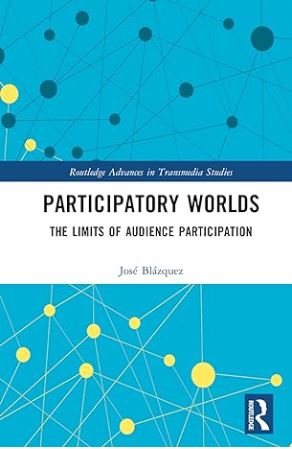

Participatory Worlds
What are participatory worlds?
Participatory worlds, as I define them in the book, are fictional worlds that allow audiences to participate in their expansion through canonical contributions and decision-making processes. There are three key principles for a storyworld to be considered a participatory world:
- The storyworld must allow audience participation in creative processes.
- Audience contributions must lead to a canonical expansion of the world.
- Participatory worlds are formed by more than one text.
The book
This book is an in-depth analysis of participatory worlds, practices beyond the mainstream models of content production and IP management that allow audience members to contribute canonically to the expansion of storyworlds, blurring the line between the traditional roles of consumers and producers.
Shifting discussions of participatory culture and cross-media production and consumption practices to more independent media contexts, the book explores the limits, borders and boundaries of participating in today’s digital media storyworlds. The text examines how audience participation works, identifying opportunities to make it a meaningful practice for audiences and an asset for IP owners, and discussing the challenges and barriers that the application of participatory culture brings along. The book defines what meaningful participation is by introducing the concept of ‘intervention’ and explains a range of factors impacting the way in which participatory worlds and relationships between producers, audiences and the world are shaped.
This volume will be of great relevance to media practitioners, scholars and students interested in transmedia storytelling, fandom, literary studies and comparative literature, new media and digital culture, gaming and media studies.
Table of contents
Certainly, audience participation is not a 21st century phenomenon, but it has unfolded into a new level in the digital age, changing the way we experience cultural artifacts and promoting the appropriation, remix, creation and circulation of culture. As initiatives based on participatory culture and collective intelligence started to provide alternative methods to access information, knowledge and culture, many media gurus and scholars began to promote the benefits of this socioeconomic and cultural paradigm. However, decades later, we can perceive that these game-changing approaches have not really taken off in many disciplines. One of these areas is the expansion of storyworlds. The introduction of this book defines and contextualises the main concepts and themes of this book, such as participatory worlds and intervention, as well as discusses the methodological approaches underpinning this research.
The first chapter investigates the relationship between producers and audiences, and between audiences and storyworlds by introducing a framework to examine the different degrees of audience intervention and define how participatory a fictional world is. The framework is organised into two sets of elements, which I designate structural and functional factors. Structural factors are related to the creation of the project/world, which depends on the producers’ decisions regarding worldbuilding, storybuilding and management of their participatory worlds. Functional factors do not relate to the project framework, but to the effective application of intervention in the storyworld.
The chapter makes use of four case studies to ensure a representative spectrum: Lord of the Craft (2011-), a Minecraft (2009)-based MMORPG (massively multiplayer online role-playing game), Grantville Gazette (2004-), an e-zine rooted in the 1632 Universe, Bar Karma (2011), a TV show broadcasted on Current TV, and Beckinfield (2012-13), a web-drama released in Theatrics.com.
This chapter defines one of the models of participatory worlds, the ‘sandpit’, which locates the participatory practices at the core of the project. By using the MMORPG Lord of the Craft as a case study, the chapter compares ‘sandpit’ model-based participatory worlds with similar mainstream commodities and fictional worlds managed by major entertainment companies (World of Warcraft and EVE Online) in order to examine the similarities and differences between these two practices. In particular, it analyses how audiences can contribute to the different layers of the storyworld (primary, secondary and tertiary texts), and explores sustainability challenges related to enticing audiences to the world and obtaining human and financial resources.
The book demonstrates that different applications of participatory worlds are possible and that they can operate similarly or differently from the standard practices of world sharing. ‘Conclusions’ reflects on previous chapters to extract the main findings about participatory worlds while connecting and extrapolating these ideas to a more general context. It critically evaluates possibilities of adoption of participatory worlds by media and entertainment industries as part of their models of management and expansion of intellectual properties as well as contemplates the limits of and challenges to the practical application of participatory culture, specifically, when it entails giving audiences/users high levels of agency (which I call ‘intervention’).
Expanded endnotes
There is third party material that did not make the book. I will be adding this here, as well as links and further insights discussed in the book. The plan is to do this during the Summer 2024, so please bear with me.
Other publications
Defining Participatory Worlds: Canonical Expansion of Fictional Worlds through Audience Participation.
Facta Ficta. Journal of Theory, Narrative & Media, 2 (2), 13-33.
Participatory Worlds: Audience Participation in Fictional Worlds
PhD thesis, University of Nottingham.
Interested in writing a review?
To request a review copy for your publication, please click here and complete the form.
Copyright © Participatory Worlds. All rights reserved.
